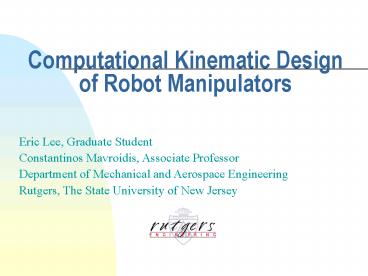Computational Kinematic Design of Robot Manipulators - PowerPoint PPT Presentation
1 / 32
Title:
Computational Kinematic Design of Robot Manipulators
Description:
Mechanical devices composed of Linkages interconnected by actuated and ... Slider-Slider Sphere Dyad, Cylinder Cylinder Binary Link: Neilsen and Roth (1995) ... – PowerPoint PPT presentation
Number of Views:125
Avg rating:3.0/5.0
Title: Computational Kinematic Design of Robot Manipulators
1
Computational Kinematic Design of Robot
Manipulators
Eric Lee, Graduate Student Constantinos
Mavroidis, Associate Professor Department of
Mechanical and Aerospace Engineering Rutgers, The
State University of New Jersey
2
Robot Manipulators
- Manipulators
- Mechanical devices composed of Linkages
interconnected by actuated and passive Joints - To produce desired Motion Properties, generate
Force/Torque for Manipulation of objects
3
Examples of Manipulators
4
Robot Manipulators Classification
- Classification according to Topology
- Open Loop Manipulator
- Closed-Loop Manipulator
5
Robot Manipulators Classification
- Classification according to Type of Joints
- RRevolute Joint (Rotation Motion)
- PPrismatic Joint (Translation Motion)
- CCylindrical Joint (Both Rotation and
Translation) - SSpherical Joint (Ball and Socket Joint, 3 DOF)
6
Kinematic Design of Manipulators
- Kinematic Design of Manipulators
- Design of Robot Manipulators that satisfy certain
geometric constrains or properties - Examples
- Design for Trajectory Following
- Design for Rigid Body Guidance
7
Computational Kinematic Design Procedures
- Given Specific Task, Performance Indexes
- Find Manipulator Type, Dimensions
8
Classification of Kinematic Design Methods
- Optimal (Approximate) Design
- When Many Solutions Exist
- When Design Constraints can only be Satisfied
Approximately - e.g. Workspace Optimization
- Exact (Analytical) Synthesis
- Constraints are Satisfied Exactly
- e.g. Rigid Body Guidance
9
Rigid Body Guidance of Spatial Manipulators
- Given
- n Precision Points (Position Orientation)
- Type of Manipulator
- Find
- All Manipulators which End-Effector could reach
all n Precision Points Exactly - Compute Geometric Parameters
10
Rigid Body Guidance
- Result in Algebraic (Polynomial) Kinematic
Constraints Equations - Each Equation represent a Hypersurface
- Solutions are the Intersecting Points of
Hypersurfaces - Multiple Solutions Exist
- Advantages
- High Precision
- High Repeatability
11
Possible Applications
- Special Purpose Industrial Manipulators
- For Repetitive Tasks
- Vehicle Components
- Landing Gear Mechanisms
- Transmission Mechanisms
- Deployable Structures
- Civil Engineering / Space Applications
12
Computational Methods in Rigid Body Guidance
- Algebraic Methods
- Technique from Computational Algebraic Geometry
and Commutative Algebra - Reduce n by n Polynomial System to 1 Polynomial
in 1 Unknown - e.g. Resultants, Grobner Basis
- Direct Numerical Methods
- Compute Numerical Solutions Directly from
Polynomial System - e.g. Polynomial (Homotopy) Continuation Method,
Interval Arithmetic
13
Previous Work in Spatial Design
- Algebraic Method
- 2R Tsai Roth (1972) Mavroidis, Alam Lee
(1999) McCarthy (1999) - 2C Roth (1967) Murray McCarthy (1999) Huang
Chang (2000) - S-S Binary Link Innocenti (1994)
- Slider-Slider Sphere Dyad, Cylinder Cylinder
Binary Link Neilsen and Roth (1995) - Continuation Method
- 3R 3 Precision Points Lee Mavroidis (2002)
14
Design Problems Solved in Rutgers Robotic Lab
- 2R 3 Positions (1999) Resultant, 2 Real
Solutions - 3R 3 Positions (2001) Continuation Method, 8
Solutions - 3R 4 Positions (2002) Continuation Method, 36
Solutions - 3R 5 Positions (2002) Interval Arithmetic,
Partially solved - PRR 4 Positions (2002) Resultant, 12 Solutions
15
Design Equations (General Formulation)
- Use Denavit Hartenberg Parameters and
Transformation Matrices - Ai Ac Link Transformation
- Loop Closure (Matrix) Equation with n Links
16
Example One 2R Design with Algebraic Method
(Resultant)
17
2R Design with Algebraic Method
- Robot Geometry
- 2 Revolute Joints
- 3 Precision Points
- Loop Closure (4x4 Matrix) Equation
18
Design Equations
- Scalar Design Equations
- 18 Nonlinear Equations in 18 Unknowns
- Elimination using Resultant
- Final Polynomial in 1 Unknown
19
Numerical Example
- End-Effector Configurations
- Final Polynomial
- Solutions for t0, 6 Solutions, 2 Real 4 Complex
20
Computer Aided Visualization
- The Two Real Solutions
- Solutions 2
- Solutions 1
21
Example 2 3R 3pp Design with Continuation Method
22
3R 3pp Design with Continuation Method
- Given
- 3 Precision Points
- Find
- All Manipulators which End-Effector could reach
all 3 Points - Loop Closure Matrix Equation
23
Design Equations
- Simplification by Algebraic Manipulations 10
Equations in 10 Unknowns
- Solution Method Continuation Method
- Software PHC (Verschelde, 1996)
- 8 Solutions satisfy the Design Constraints
24
Numerical Results
- End-Effector Configurations
- 8 Solutions 4 Real 4 Complex
25
Computer Aided Visualization (I)
- (Real) Solution 1 and 2 at Three Precision Points
26
Computer Aided Visualization (II)
- (Real) Solution 3 and 4 at Three Precision Points
27
Example 3 3R 5pp Design with Interval Analysis
28
3R 5pp Design with Interval Analysis
- Given
- 5 Precision Points
- Find
- All Manipulators which End-Effector could reach
all 5 Points
- Solution Method Interval Analysis
- Search for all Real Solutions within a Predefined
Bounded Region in Rn
29
Numerical Results
- Implementation
- C Interval Analysis Library ALIAS
- PVM on Cluster of PCs (5 days on 26 PCs)
- End-Effector Configurations
- Results 13 (Real) Solutions
30
Future Work
31
Future Work
- Develop Algorithms for Other Open and Closed Loop
Manipulator Design Problems - Manipulator Design Automation with CAD
32
Acknowledgements
- Financial Support Computational Science Graduate
Fellowship of DOE, NSF CAREER Award (Prof.
Mavroidis) - Professor Jan Verschelde (University of Illinois
at Chicago) and Dr. Charles Wampler of General
Motors for assistance in using Continuation
Software - Professor Jean-Pierre Merlet (INRIA Sophia
Antipolis) for collaboration in using Interval
Analysis































